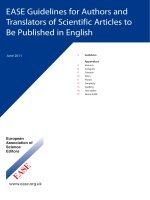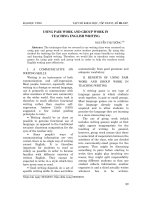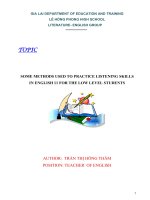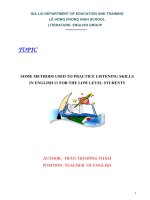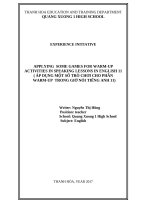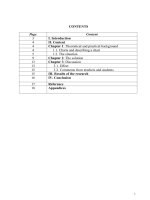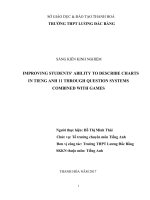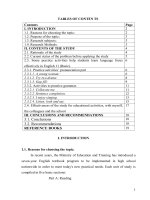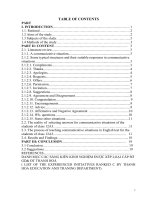Improving students ability to describe charts in english 11 through question system combined with games
Bạn đang xem bản rút gọn của tài liệu. Xem và tải ngay bản đầy đủ của tài liệu tại đây (224.89 KB, 18 trang )
CONTENTS
Page
3
4
4
4
5
9
13
13
15
15
16
17
18
Content
I. Introduction
II. Content
Chapter 1: Theoretical and practical background
1.1. Charts and describing a chart
1.2. The situation
Chapter 2: The solution
Chapter 3: Discussion
3.1. Effect
3.2. Comments from teachers and students
III. Results of the research
IV. Conclusion
Reference
Appendices
1
CONTRACTED WORDS
etc
ICT
IEPs
inc
LSAs
mins
Ss
T
et cetera
Information and Communication Technologies
Individualized Education Programs
Incorporated
Low Specific Activities
Minutes
Students
Teacher
2
I. INTRODUCTION
1. The reason for choosing the subject:
Nowadays, in the integration period and with the globalization trend, foreign
languages, especially English, play a very important role in society. English
becomes an international language. It is used in many fields such as business,
trade, communications, tourism and diplomatic activities, etc... . More than fifty
countries in the world use English as their official language and it is used as the
second language in nearly eighty nations. Therefore, English is an ology which
is never saturated due to its newness and popularity in all fields. Our Party and
government showed their particular interest in teaching and learning foreign
languages.
English is considered as a main subject at upper secondary school.
Teaching English with the communicative approach is our aim. How to improve
all skills (listening, speaking, reading and writing) completely for our students is
our duty. All skills are important and it is necessary for us to develop them.
Curriculum and textbooks are issued with a view to carrying out this aim
successfully. However, writing skill seems to be one of the most difficult skills
for students. Most writing tasks, for example describing charts, are not
interesting enough to attract them. They do not even know how to deal with
these tasks. Their writings are only simple descriptions without comparisons.
“What can I do to help my students?” “In what way do my students describe
them well?” “What should I do to make these writing tasks easier and more
attractive?” The best way I did to assist them is that I used the eliciting questions
combined with games to guide them.
I would like to share my teaching experience “Improving students’ ability to
describe charts in Tieng Anh 11 through question systems combined with
games” in the hope that my colleagues can apply in teaching and we can discuss
more to get the best result in teaching how to describe charts.
2. The objective of the study:
As an English teacher at high school for many years, I am always concerned
about the current situation of foreign language teaching and learning of students
in the province.Our students seem inferior to students in other provinces about
foreign language capability. So what is the cause of this situation? Is it because
teachers are not qualified? Or those students do not have the ability to learn
foreign language by local accent and direct communication skills are not
flexible? May be due to improper care level of the school for this subject? All
these questions have yet to be answered. These obstacles not only are in our
province. Why other provincial students study foreign language bettwe than our
students ? The main responsibility belongs to teachers who teach in school. In
addiction, the headmastr, the leaders of the education sector in the province.
Everyon must identify targets clearly and strive to achieve that goal. My
3
objective in work is going on learning, finding out experience to improve the
quality of teaching, make students trust in teachers and have more and more
successful students. More specifically, I want my work to achieve success in my
own ability. During the process of teaching a foreign language in high school,I
alwways accumulate, find out experience, inovate teaching methods to suit each
student object and generate excitement in learning so that they have more
passion, more inthusiasm in studying. And the goal of this project is to draw on
experience in teaching describing charts in English for students 11 th grade
through question system combined with games and shere ideas with collegues.
3. The object of the study:
In the framework of the subject and with limited ability, I will present a few
teachniques taught to describe charts (through question system combined with
games) as requred under the high school programs and textbook. With the
criteria of a good description, it includes: tigh layout, accurate grammar
structure, pure prose, expressive and flexible wording, I think that this is not
easy for many high school students. In this theme I will refer to how to describe
charts as required, how to use flexible words and how to compare the
infotmation better to make a good description for students 11th grade.
4. Study method:
The method of describing charts is the one of the topic that I am very interested
in the teaching process. Through many years of working with students, I find
that when students have to describe a chart, they often feel confused and do not
know where to start. The idea or no idea, or unclear ideas. Hence, students are
often afraid to describe a chart. Understanding the difficulties and psychological
concerns of the students, I alwways try to help my students to give the problem,
solve the problem and end the problem to make describing a chart more
effective,. Descring techniques must be practiced every day to help students
describe them skillfully. Teacher must stimulate students to explore their own
potential and help them learn how to present their ideas, their concerns things by
foreign language that they are learning.
II. CONTENT:
1. The theoretical background
1.1.
Charts and describing a chart
a.
Charts
A chart is a graphical representation of data, in which "the data is represented
by symbols, such as bars in a bar chart, lines in a line chart, or slices in a pie
chart". A chart can represent tabular numeric data, functions or some kinds of
qualitative structure and provides different info.
The term "chart" as a graphical representation of data has multiple meanings:
4
A data chart is a type of diagram or graph, that organizes and represents a
set of numerical or qualitative data.
•
Maps that are adorned with extra information for some specific purpose
are often known as charts, such as a nautical chart or aeronautical chart.
•
Other domain specific constructs are sometimes called charts, such as
the chord chart in music notation or a record chart for album popularity.
Charts are often used to ease understanding of large quantities of data and the
relationships between parts of the data. Charts can usually be read more quickly
than the raw data that they are produced from. They are used in a wide variety of
fields, and can be created by hand (often on graph paper) or by computer using
a charting application. Certain types of charts are more useful for presenting a
given data set than others. For example, data that presents percentages in
different groups (such as "satisfied, not satisfied, unsure") are often displayed in
a pie chart, but may be more easily understood when presented in a
horizontal bar chart. On the other hand, data that represents numbers that change
over a period of time (such as "annual revenue from 1990 to 2000") might be
best shown as a line chart.
b. Describing a chart
In textbooks at upper secondary school, there are bar charts and pie charts so I
only mention two these types. These types of charts are usually used for
comparison purposes (unlike line charts, which describe changes).
When you write about a bar chart it is important to look first at the Chart Title.
This tells you what information the chart displays and you can use this
information in your description.
Then look at the X and Y axes. The titles of these axes sometimes give you
information you can use in your description. It is important also to look at the
UNITS.
Bar charts show similarities and differences. When describing these charts you
need to make comparisons. You also need to group together any columns which
have broad similarities.
To write a short description of the chart ask yourself (and answer!) the
following questions:
1.
What exactly does the chart show? (Use the chart title to help you answer
this question)
2.
What are the axes and what are the units?
3.
What similarities are there?
4.
Is it possible to put some of the columns into one or more groups?
5.
What differences are there?
Answering these questions will help you to write a short description of this
simple bar chart.
Pie charts normally show proportion, which can be measured in percentages or
fractions. This type of charts shows the relative size of something. So we can
only make comparisons; we cannot say anything about change.
•
5
2. The fact of the matter before applying the experience:
In the writing tasks in Tieng Anh 10 and Tieng Anh 12 textbooks there are
eliciting questions so students can have some ideas for their writings to make
comparisons but in the tasks in Tieng Anh 11 there is not any eliciting questions
for them to write except for the chart, useful language and the requirements.
Students find it difficult to write.
In writing section of Unit 7 – World population (Tieng Anh 11-Page 86), a pie
chart is given with the requirement “Study the chart carefully then write a
paragraph of 100-120 words, describing the information in the chart”.
Oceania
Northern 2%
America
Latin
America
6%
South Asia
32%
8%
Africa
11%
Europe
East Asia
15%
26%
Students have to do the task with the following suggestions of useful language:
It can be seen that
distributed unevenly
account for… per cent
more than double the population of
half as much as/ nearly half of
rank first/ last
And the beginning “The chart shows the distribution of world population by
region. …”
6
With all these cues, Hoang Minh Quang - class 11A5 - wrote:
Hoang Minh Quang’s writing
Errors
The chart shows the distribution of world
population by region. It can be seen that → lack “the world” and verb
population distributed unevenly. South Asia → form of the verb
account for 32 percent and more than double
→ lack the verb and wrong
the population of Europe. Latin America more
information
than double the population of Europe. → form of the verb
Northern America nearly double the → spoken language
population of Africa. Oceania account for 2
percent. Rank first South Asia, second East
Asia and seventh Oceania.
In Unit 11 – Sources of energy (Tieng Anh 11-Page 130), a bar chart is given for
students to write the description of it.
In Task 2, they are required to write the same writing as Task 1. However, they
gave some mistakes in their writings.
Dao Thi Lien - class 11A4 - wrote:
Dao Thi Lien’s writing
Errors
The chart shows the energy consumption in
Highland in 2005. As can be seen, the total → spelling mistake
energy consumption was 170 million ton.
→ wrong information
Petroleum made up the largest amount of this
→ wrong answer
figure (50 million tons). This was followed by
the consumption of smallest (45 million tons). → wrong word
Nuclear and hydroelectricity made up the
biggest amount of energy consumption (75
million tons)
7
Chu Van Kien – class 11A5 – also wrote:
Chu Van Kien’s writing
Errors
The chart shows the energy consumption in
Highland in 2005. As can be seen, the total
energy consumption was 170 million tons. → wrong information
Petroleum made up the largest amount of this
figure (75 million tons). This was followed by → wrong information
the
consumption
of
nuclear
and
hydroelectricity (50 million tons). Coal made
up the smallest amount of energy consumption
(45 million tons)
And many students did like these.
After doing Task 1 and Task 2 with the requirements in textbook, students did
Task 3 by combining two these tasks in turn.
3. The solution:
In order to improve writing skill in describing charts for students, I carried out a
few techniques at classes 11A4,11A5 and 11A6 in this school-year (2016-2017).
I gave out posters and handouts with the eliciting questions for these writing
tasks. In order to make them more interesting and help students concentrate to
the lessons, I used these eliciting questions in games such as “lucky number” or
“typhoon”.
Lucky number
- Divide the class into two teams.
- Representatives of each team choose the numbers in turn
- If they get a “lucky number”, they will have 2 points without any questions.
- If they have a correct answer, they will get 2 points.
- If they don’t answer the question, the chance will be for the other team.
Typhoon
- Divide the class into two teams.
- Representatives of each team choose the numbers in turn.
- They will get 5 points with a correct answer.
- If they get a “star”, they will get 5 points without a question.
- If they get a “plus…”, the point given will be added for them when they have
a correct answer.
- If they get a “minus…”, they will lose the point which the number gave.
- Unluckily, they will lose all the point they got when they get the word
“typhoon”
3.1. Unit 7: World population (Page 86)
- Aim: help students have comparisons among the regions about the
distribution of world population.
- Time: 15 minutes
- Preparation:
+ a poster and handouts with eliciting questions
+ a poster presenting game “Typhoon”
8
- Procedure:
Stage
Procedure
PreActivity 1: Discussion (5’)
writing
Deliver handouts. (Appendix 1)
Eliciting questions (Tieng Anh 11 – Unit 7
– Page 86)
1.
How great is the percentage in total?
2.
Which region contributes the largest
in world population? What is the proportion
of it?
3.
Which region makes up the smallest in
world population? What is the percentage?
4.
Which region ranks second? What
percentage is it?
5.
How is Northern America in
comparison with Oceania?
6.
Which region has nearly double the
population of Northern America?
7.
Which region has the contribution to
the world population more than that of
Africa?
8.
Which region makes up nearly half of
Europe?
Discuss to find out the information
which the questions ask. (Appendix 2)
Suggested answers:
1. 100%
2. South Asia contributes the largest in
world population. It accounts for 32%.
3. Oceania makes up the smallest in
world population with 2%.
4. East Asia ranks second, accounting
for 26 %
5. Northern America has three times of
the population of Oceania
6. Africa has nearly double the
population of Northern America
7. Europe has the contribution to the
world population more than that of
Africa
8. Latin America makes up nearly half of
Europe
Activity 2: Game “Typhoon” (10’)
Interaction
T
Pairs
T
Teams
T-Ss
9
Stage
Procedure
Interaction
Hang the poster with eliciting
questions out. (Appendix 1)
Stick the poster presenting game
“Typhoon” on the board.
Divide the class into 2 teams.
Ask Ss to play the game.
Feedback
3.2.Unit 11: Energy sources (page 130)
- Aim: help students have comparisons about the energy consumption between
two certain points of time.
-Time: 15 minutes
- Preparation:
+ a poster and handouts with eliciting questions
+ a poster presenting game “Lucky number”
-Procedure:
Stage
Procedure
Interaction
PreActivity 1: Asking and answering (3’)
writing
Ask Ss some questions to recognize
the chart. (Appendix 3)
T-Ss
1.
What exactly does this chart show?
T
2.
How many colors are there?
3.
What color stands for coal, nuclear
and hydroelectricity and petroleum in turn?
4.
How many points of time are given?
What are they?
Observe the chart and give the ideas.
Expected answers:
Ss
1. It shows the energy consumption in
Highland in 2000 and 2005.
2. Three
3. Green stands for coal, red for nuclear
and hydroelectricity and purple for
petroleum
T
4. Two. They are 2000 and 2005
Activity 1: Discussion (4’)
Deliver handouts. (Appendix 4)
1.
How was the trend in energy
consumption between 2000 and 2005?
2.
Which energy made up the largest
amount of energy consumption in 2000?
How was it in 2005?
3.
Which energy had the smallest amount
of this figure in 2000? Did it increase or
Pairs
10
Stage
Procedure
decrease
in
2005?
How
did
it
increase/decrease?
4.
What about coal? Did it rise/fall
dramatically or slightly?
5.
What does this trend in energy
consumption mean?
Discuss to find out the information
which the questions ask. (Appendix 5)
Suggested answer:
1. The total energy consumption of 2005
(170 million tons) was higher than
that of 2000 (117 million tons).
2. In 2000, petroleum made up the
largest amount of energy consumption
(57 million tons) while in 2005 it
decreased slightly of 7 million tons.
3. Nuclear and hydroelectricity had the
smallest amount of this figure in 2000.
It increased quickly from 20 million
tons (in 2000) to 75 million tons (in
2005), which was the highest amount.
4. Coal had a slow rise from 40 million
ton to 45 million tons.
5. People in Highland had the trend of
using unpolluted sources of energy.
Activity 2:Game “Lucky number” (8’)
Hang the poster with eliciting
questions out. (Appendix 4)
Stick the poster presenting game
“Lucky number” on the board.
Divide the class into 2 teams.
Ask Ss to play the game.
Feedback
Interaction
T
Teams
T-Ss
4. Effect
4.1. Practical effect
After practicing these changes in my lectures, my students has made some
progress in their writings. Their writings not only contained fewer mistakes but
also showed a clear comparison. They know how to describe a chart and are
confident to write as well.
Unit 7 – World population (Tieng Anh 11-Page 86)
In this writing lesson, Le Xuan Hieu – class 11A5 – wrote:
11
Le Xuan Hieu’s writing
Comment
The chart shows the distribution of world
population by region. It can be seen that world
- A good comparison
population distributed unevenly. South Asia
ranks first and accounts for thirty two percent
in population. And South Asia is more than
double
the population of Europe which
accounts for fifteen percent. Latin America
accounts for eight percent in world population
and it is nearly half of Europe’s population.
East Asia is over twice as much as Africa with
twenty six percent in world population.
Oceania ranks last with two percent in
population and it account for one-third of
Northern America’s population.
Unit 11 – Sources of energy (Tieng Anh 11-Page 130)
Nguyen Thi Nhung – class 11A5- described the chart in this writing section like
this:
Nguyen Thi Nhung’s writing
Comment
The chart shows the energy consumption in
Highland in 2000 and 2005. As you can see
-Use vocabulary perfectly
from the chart, the total energy consumption of
-Compare well
2005 (170 million tons) was higher than that of
2000 (117 million tons). In 2000, petroleum
made up the largest amount of this figure (57
million tons) while in 2005 it decreased
slightly of 7 million tons. Besides, nuclear and
hydroelectricity increased quickly from 20
million tons (in 2000) to 75 million tons (in
2005), which was the highest amount. In
addition, coal had a slow rise from 40 million
ton to 45 million tons.
To sum up, people in Highland had the trend of
using unpolluted sources of energy.
4.2. Comments from teachers and studens
I made a survey to know what students find about writing lessons by the
questionnaire (Appendix 6) and had some replied information as below.
Most students know that writing lessons help them not only practise writing skill
but also develop all skills fully. They also stated that writing is very important
but it is sometimes difficult. As a result, although they prepared the lesson
before the class, they still had difficulties when doing the task. Therefore, they
did not participate in writing lessons actively.
12
When I carried out the survey with class 11A5 – a rather good at English class
with 37 students, 26 students believe that the writing lessons are very important
- containing 70.3%, 9 students think they are not very important - containing
24,3,% and no one finds they are not important at all. While only 2 students in
this class never prepare the lesson before class – containing 5.4%, most of them
always or sometimes do this work – containing 94,7%. However, a similar
number of the students (93,1% with 37 students) find it difficult to describe a
chart. Through the questionnaire, students also said that there are 2 main reasons
that make them difficult to describe a chart. They are “lack of vocabulary and
you don’t know how to write”. 100% (37 students) in this class lack of
vocabulary when describing a chart. With the reason “You don’t know how to
write”, 4 students always (10.8%), 24 students sometimes (65%) and 10 students
never (24.2%).
These students stated that the way of using eliciting questions combined with
games was carried out in the writing lessons such as Unit 7 – World population
(Tieng Anh 11-Page 86) and Unit 11 – Sources of energy (Tieng Anh 11-Page
130), they find it easier and more exciting when writing. 32 students (86,5%)
agreed that using eliciting questions combined with games not only makes
writing lessons more interesting but also help them understand the information
given from the chart and know how to describe it.
For the teachers who observed the class (Appendix 7), they also appreciated the
way that I guided my students to describe a chart. Most of them agreed strongly
or apparently with the criteria given in the observation sheet, especially
objectives, materials, activities and techniques.
These figures have already shown that using eliciting questions combined with
games in describing a chart can help students practise this skill more effectively.
4.3. Results of the research
After using this technique, I have had the following results of the convey from 3
classes : 11A4, 11A5 , 11A6 at the end of the school year 2016 - 2017 :
Class Before applying experience
After applying experience
( the beginning of the
( the end of the school year )
school year )
Excellent Average
Weak
Excellent
Average
Weak
– good
(bad)
– good
(bad)
11A4
32%
43%
25%
36%
59%
7%
11A5
40%
37%
23%
45%
50%
5%
11A6
38%
42%
20%
43%
53%
4%
It is indicated from the table of statistics above that the quality of the subject has
considerably changed . They are much higher and better than those at the
beginning of the school year . Up to now, there’s been enough evidence to affirm
that organizing games in speaking lessons has resulted in much effect in
teaching English particularly speaking skill.
13
III. CONCLUSION:
Realizing the difficulties students faced in describing a chart, I tried to find out a
good way for them to solve their problem. This technique has helped my
students find their tasks easier to do, so they feel more confident to take part in
the lessons.
I present this teaching experience with a view to sharing my own experiment in
teaching students how to describe a chart with colleagues though everything has
its strong points and weak ones.
Because of the shortage of time, this methods must have some mistakes that I
cannot discover. I’m willing to receive readers’ comment and if possible, you
can add some more techniques so that I can improve it. I hope this methods will
help you and your students find it more exciting and interesting in describing a
chart.
If the writing tasks have available eliciting questions, teacher can use games to
make the lesson more exciting and attractive. I think it is also a good way to
motivate students’ studying spirit which bring much benefit in teaching and
learning.
Thank you very much!
LEADER’S CONFIRMATION
Thanh Hoa, April 15th, 2017
I am sure this is my own work,
not copying from anyone
Writer
Do Thi Thanh
14
REFERENCE
1. Reference material from:
- />- />- />-
-
2. Tieng Anh 11 – Giao Duc publisher – 2007
15
APPENDICES
Appendix 1
Eliciting questions (Tieng Anh 11 – Unit 7 – Page 86)
1. How great is the percentage in total?
2. Which region contributes the largest in world population? What is the
proportion of it?
3. Which region makes up the smallest in world population? What is the
percentage?
4. Which region ranks second? What percentage is it?
5. How is Northern America in comparison with Oceania?
6. Which region has nearly double the population of Northern America?
7. Which region has the contribution to the world population more than that of
Africa?
8. Which region makes up nearly half of Europe?
Appendix 2
Suggested answers for eliciting questions (Tieng Anh 11 – Unit 7 – Page 86)
1. 100%
2. South Asia contributes the largest in world population. It accounts for
32%.
3. Oceania makes up the smallest in world population with 2%.
4. East Asia ranks second, accounting for 26 %
5. Northern America has three times of the population of Oceania
6. Africa has nearly double the population of Northern America
7. Europe has the contribution to the world population more than that of
Africa
8. Latin America makes up nearly half of Europe
Appendix 3
Eliciting questions for recognition (Tieng Anh 11 – Unit 11 – Page 130)
1.What exactly does this chart show?
2.How many colors are there?
3.What color stands for coal, nuclear and hydroelectricity and petroleum in turn?
4.How many points of time are given? What are they?
Appendix 4
Eliciting questions for studying (Tieng Anh 11 – Unit 11 – Page 130)
1.How was the trend in energy consumption between 2000 and 2005?
2.Which energy made up the largest amount of energy consumption in 2000?
How was it in 2005?
3.Which energy had the smallest amount of this figure in 2000? Did it increase
or decrease in 2005? How did it increase/decrease?
16
4.What about coal? Did it rise/fall dramatically or slightly?
5.What does this trend in energy consumption mean?
Appendix 5
Suggested answer for eliciting questions for studying (Tieng Anh 11 – Unit
11 – Page 130)
1. The total energy consumption of 2005 (170 million tons) was higher than
that of 2000 (117 million tons).
2. In 2000, petroleum made up the largest amount of energy consumption
(57 million tons) while in 2005 it decreased slightly of 7 million tons.
3. Nuclear and hydroelectricity had the smallest amount of this figure in
2000. It increased quickly from 20 million tons (in 2000) to 75 million
tons (in 2005), which was the highest amount.
4. Coal had a slow rise from 40 million ton to 45 million tons.
5. People in Highland had the trend of using unpolluted sources of energy.
Appendix 6:
Questionnaire
1. What do you think the aims of the writing lessons are?
a. practise writing skill b. develop all skills fully
c. both of them
2. How important do you think writing lessons are?
a. very important
b. not very important
c. not important at all
3. Did you prepare the lessons before the class?
a. Yes, always.
b. Yes, sometimes.
c. No, never.
4. Do you think describing a chart is difficult?
a. Yes, always.
b. Yes, sometimes.
c. No, never.
5. You have difficulties when describing a chart because of the reasons…..
Reasons
always
sometimes
Never
1 You don’t understand the chart
2 Lack of vocabulary
3 You don’t know how to write.
4 Your grammar is not good enough.
5 You are not confident
6. Did you participate in writing lessons actively?
a. Yes, always.
b. Yes, sometimes.
c. Seldom
d. No, never.
7. How much can you gain after writing lesson if using eliciting questions
combined with games? You can add your own ideas.
a. understand the information given from the chart.
b. writing lessons are more interesting.
c. know how to describe a chart.
d. be still unable to do this type of writing tasks.
e. a, b and c
17
f. other reasons: …………………………………………………………
Appendix 7:
Observation sheet
[Name] School
Lesson Observation Notes and Checklist
Name of teacher:
Date of observe:
Subject: English
/
/ 201
Name of observer:
Length of lesson:
mins
Year Group/ Set/ Class:
Comments by Observer, including specific examples of practice which meets or
does not meet the criteria in the checklist overleaf:
Comments by Teacher:
18
